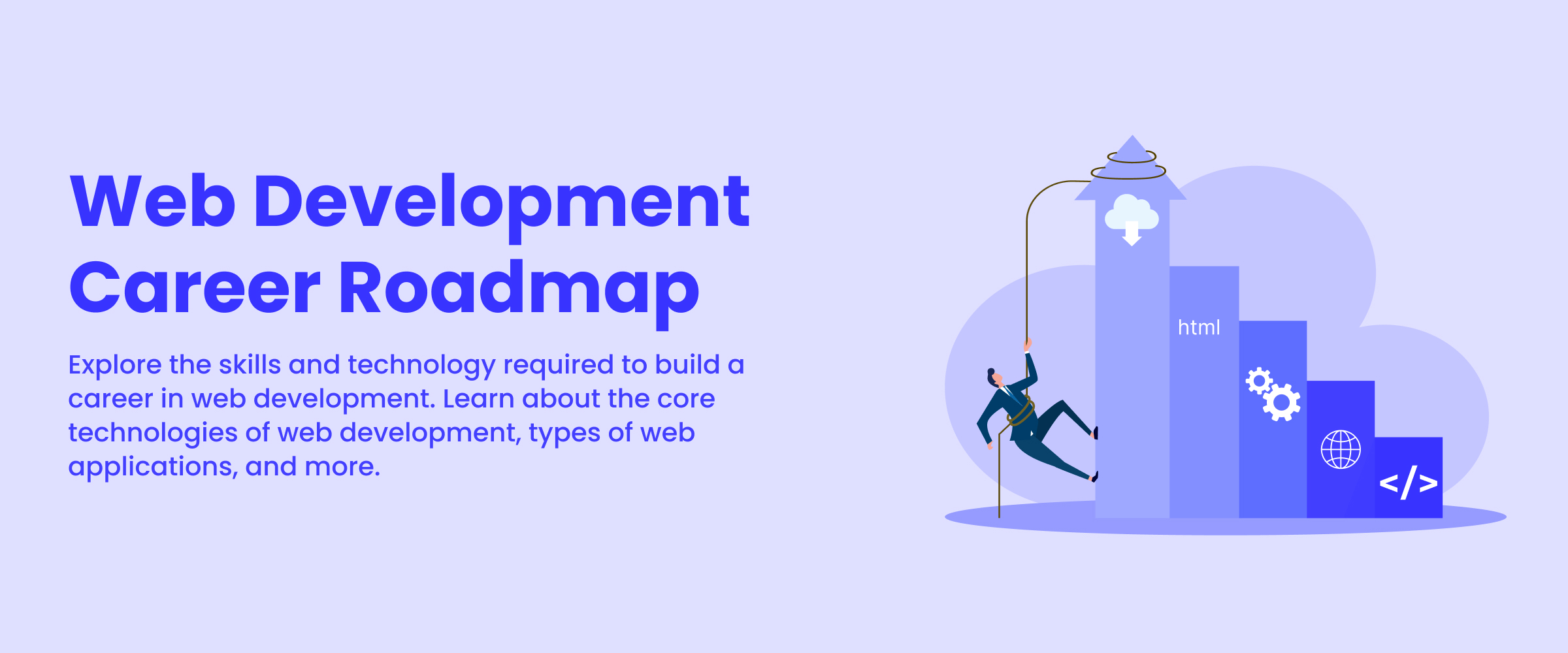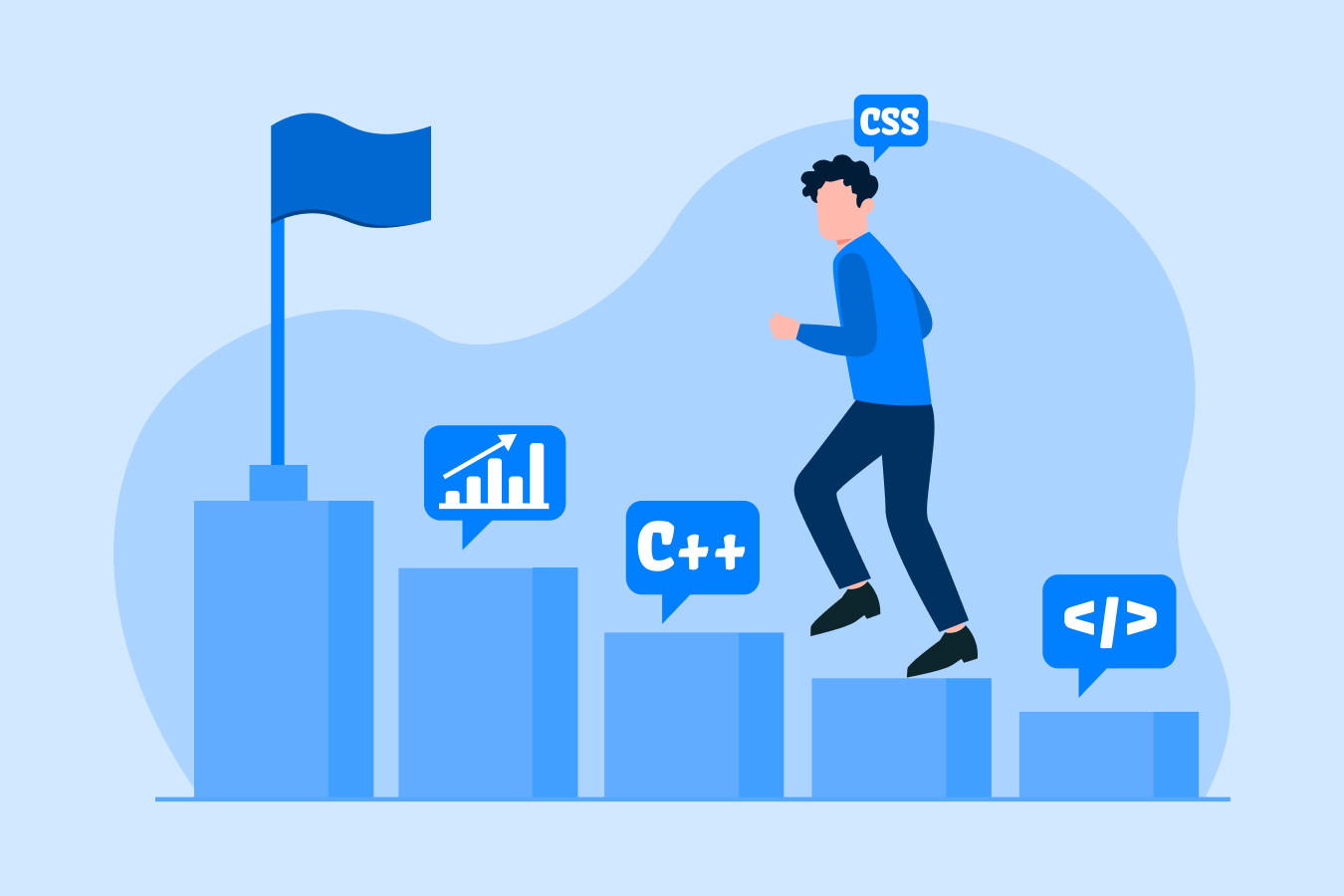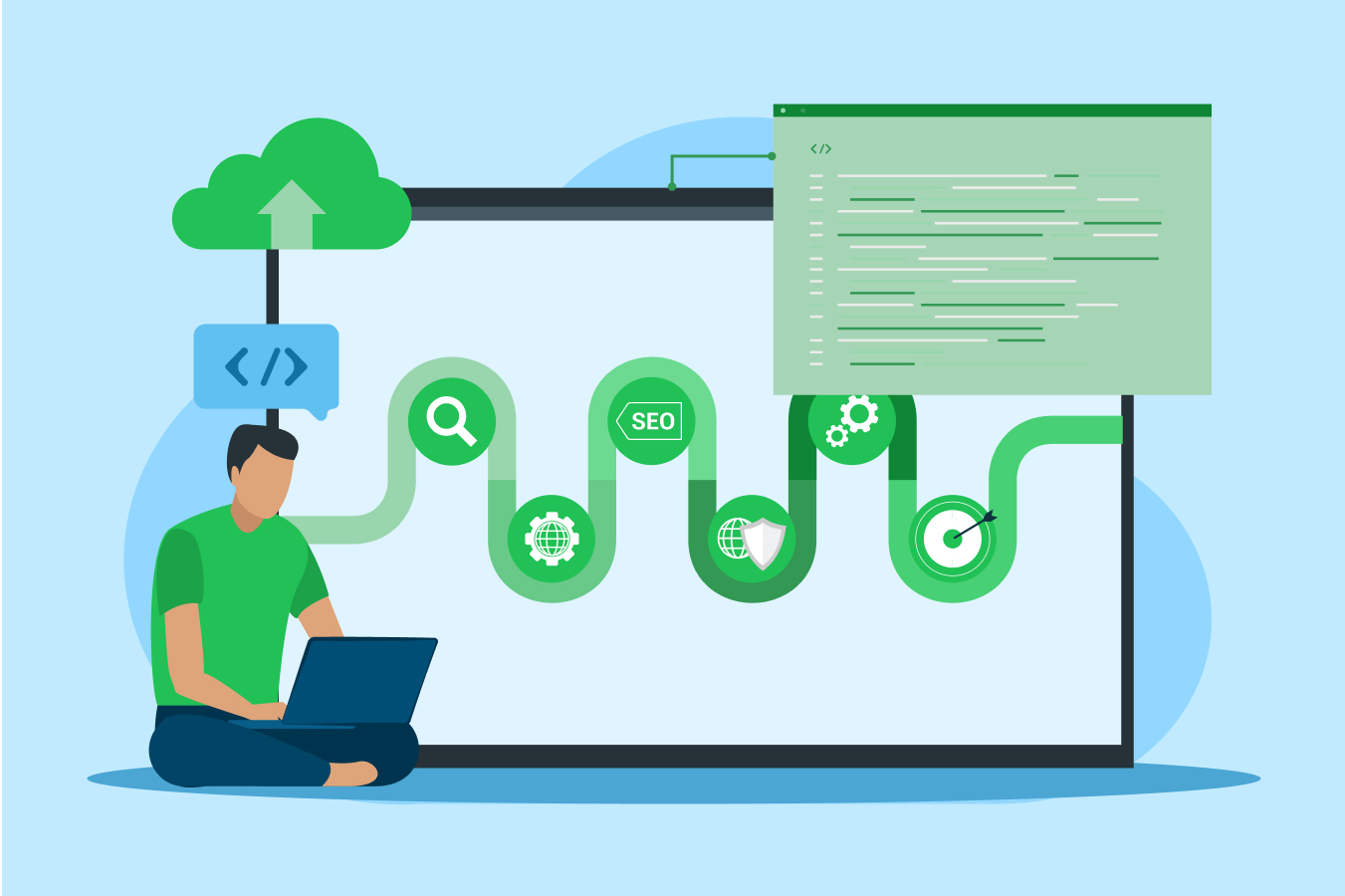Web Development Roadmap: A Comprehensive Guide for Beginners
The digitization has spurred the demand for web developer professionals. Businesses and organizations strive to establish a strong online presence. Therefore, to build a digital presence, companies hire web developers to create engaging and user-friendly websites and web applications. Indeed, web development has emerged as a highly sought-after and lucrative field, offering endless opportunities for growth and innovation.
Whether you are a complete novice or looking to transition into this field, having a well-defined web development roadmap can be the key to success. Read on to find a step-by-step guide on how to build a career in web development.
Understanding Web Development and Its Types
Web development is the process of building, creating, and maintaining websites. It involves various tasks, such as coding, designing layouts and visual elements, optimizing performance for speed and user experience (UX), etc.
There are different aspects of web development, including front-end and back-end development.
- Frontend Development: It involves creating the visual and interactive elements that users see and interact with on a website or web application. Frontend developers use languages like JavaScript, HTML, and CSS to build the user interface, ensuring an engaging and responsive experience across different devices and browsers.
- Backend Development: It focuses on the server-side components of a website or web application. Backend developers work with programming languages like Python, Java, or PHP to build the underlying logic, handle data processing, and interact with databases.
Tip: If you want to kickstart your career in web development and ace the frontend and backend development processes, consider enrolling in a full-stack development course with a placement.
Web Development Roadmap for Beginners
Embarking on a journey into web development can seem daunting at first. However, following a structured web development roadmap, you can break down the learning process into manageable steps and develop the necessary skills to become a proficient web developer.
1. Focus on Formal Education
Formal education can provide a solid foundation for your web development journey. By pursuing the degree course, you can access structured curriculums, experienced instructors, and opportunities for hands-on learning and project-based assignments. A bachelor’s or master’s degree in computer science or a related field is essential for building your career in web development.
2. Enroll in Relevant Professional Training Courses
Learning programming languages and knowing UI/UX design, WordPress, Angular framework, cloud development, etc., are crucial to becoming a skilled web developer. Some of the courses you can pursue include:
- Core Java Course
- Programming with Python Course
- WordPress Course
- Angular Course


3. Master the Essential Web Development Skills
Mastering skills is important to building a web development career. This section of the web development roadmap highlights the core abilities to meet job requirements and industry standards. Learning the following skills will help you create dynamic, user-friendly websites and applications:
i. Proficiency in Programming Languages
Some of the important programming languages a web developer should master include:
- HTML (HyperText Markup Language): This language is used to structure and organize content on a web page. Learning HTML involves understanding its syntax, elements, and best practices for creating accessible and search engine-friendly content.
- CSS (Cascading Style Sheets): It styles and controls the visual presentation of web pages. Mastering CSS involves understanding selectors, properties, values, and advanced techniques in animations, transitions, and responsive design principles.
- JavaScript: JavaScript is a programming language that brings interactivity and dynamic behavior to web pages. Learning it involves mastering its syntax, data types, functions, and control structures and working with popular libraries and frameworks.
- Python: A versatile programming language widely used in web development, data science, automation, and artificial intelligence. Learning Python involves understanding its syntax, data structures, object-oriented programming, and frameworks like Django and Flask for web development.
- Ruby: A dynamic, object-oriented programming language known for its simplicity and developer-friendly syntax. It is commonly used in web development, particularly with the Ruby on Rails framework. Mastering Ruby includes understanding its syntax, metaprogramming, and Rails conventions for building scalable applications.
- PHP: A server-side scripting language designed for web development and widely used to create dynamic and interactive websites. Learning PHP involves working with its syntax, integrating with databases like MySQL, handling form data, and using frameworks like Laravel for robust web applications.
ii. Knowledge of Websites and Web Servers
Learn about the fundamental concepts of how websites work and the role of web servers. Websites are collections of web pages identified by a common domain name and hosted on a server. A web server is a system that stores files and software and facilitates data exchange with other devices over the internet.
Developing a solid understanding of this client-server architecture and the underlying infrastructure is essential. This model illustrates how clients (browsers) interact with servers to retrieve data. Learn about the following aspects:
- Scalability: Understanding how servers handle multiple requests helps developers design scalable applications that can manage increased traffic without performance degradation.
- Security: Acquire knowledge of how data is transmitted between clients and servers. It enables developers to implement security measures such as encryption and secure authentication methods.
- Performance Optimization: Familiarity with server configurations can lead to better performance optimizations, ensuring faster load times and improved user experiences.
iii. Expertise in Frontend and Backend Development Tools
Having expertise in both frontend and backend tools enables developers to become full-stack web developers. This versatility allows developers to:
- Build Comprehensive Applications: Understanding both sides of development helps create cohesive applications where the front end and back end work seamlessly together.
- Improve Collaboration: Full-stack developers can communicate effectively with both frontend and backend teams, bridging gaps between different areas of expertise.
- Enhance Problem-Solving Skills: Knowledge of the entire stack equips developers with a holistic view of application architecture, enabling them to troubleshoot issues more effectively.
iv. Learn Important Frontend and Backend Development Tools
In the field of web development, it is essential to have the right tools to create a high-performing website or web application. Choosing the appropriate programming languages, frameworks, version control systems, design tools, databases, and web servers is crucial for success. It is crucial in the roadmap for web developers, whether you desire to work on the front end or back end.
Here is a table you can utilize to explore frontend and backend tools:
| Category | Frontend Development Tools | Backend Development Tools |
| Programming Languages | HTML, CSS, JavaScript | Python, PHP, Java, JavaScript (Node.js), Ruby |
| Frameworks & Libraries | React, Angular, Vue.js, Bootstrap, jQuery | Django, Laravel, Express.js, Spring, Ruby on Rails |
| Version Control Systems | Git | Git |
| Design Tools | Figma, Adobe XD, Sketch, Webflow | Whimsical, Swagger |
| Databases | SQLite, IndexedDB | MySQL, PostgreSQL, MongoDB, Oracle |
| Web Servers | Apache, Nginx, Node.js | Apache, Nginx, IIS |
v. Understanding of Responsive Web Design
Ensuring responsiveness is crucial for providing an optimal user experience across various screen sizes and devices. Responsive web design techniques, such as media queries, flexbox, and CSS grid layouts, ensure that websites and web applications adapt seamlessly to different screen sizes and devices.
Prioritize building responsive websites and applications from the outset to ensure seamless accessibility and usability for users on desktops, mobiles, tablets, and other devices.
Here are a few reasons why a responsive website should be the focus of frontend development:
- Mobile Device Usage: As more people use their smartphones and tablets to browse, the demand for cross-device compatibility arises. A responsive design allows websites to automatically adjust their layout based on different screen sizes, providing mobile users with a smooth and seamless experience.
- User Experience: A thoughtfully crafted responsive website will maintain a consistent appearance and user experience. It will ensure optimal usability and functionality on all devices.
- SEO Benefits: Google rewards responsive websites because they provide a better user experience. Google’s algorithm now ranks mobile-friendly websites higher, and with more than half of global internet traffic coming from mobile devices, optimizing for responsiveness is a strategy that simply cannot be ignored.
vi. Learn Version Control System with Git
Version control systems are essential tools for web developers, allowing them to track changes to their codebase, collaborate with others, and manage different versions of their projects effectively. Among the various version control systems available, Git has emerged as the industry standard, widely adopted by individual developers, small teams, and large organizations alike.
Learning Git and GitHub involves understanding its core concepts, such as repositories, branches, commits, and merging. By taking a Github course, you’ll learn how to initialize a new Git repository, stage and commit changes, create and switch between branches, and merge changes from different branches.
Version control like Git provides several key benefits, including:
- Collaboration: When multiple developers work on the same project, version control helps prevent conflicts by managing changes made by different team members. This is crucial in ensuring that everyone is aligned and that no one overwrites another’s work.
- Backup and Recovery: VCS serves as a backup system for your code. If something goes wrong or if you need to revert to a previous version of your project, you can easily do so without losing any progress.
- History Tracking: Version control maintains a detailed history of changes made to the codebase. Developers can see who made changes and the reasons behind those changes. This transparency is vital for accountability and understanding project evolution.
vii. Know How to Deploy Web Applications
Deployment is the process of transferring your application from a development or staging environment to a production environment, where it can be accessed and utilized by end users. Understanding the various deployment options available is essential for ensuring that your application runs smoothly and efficiently in a live setting.
Here are the preferred options used for the deployment of web applications:
- Shared Hosting: Shared hosting is a cost-effective solution for small to medium-sized websites or applications. In this setup, multiple websites share resources on a single server, which can significantly reduce costs.
- Cloud-based Platforms: Cloud providers like Microsoft Azure, Amazon Web Services (AWS), and Google Cloud Platform offer scalable and flexible hosting solutions, allowing you to easily provision and manage resources based on your application’s needs. You can also take a cloud computing with AWS course to sharpen your skills and gain knowledge of this aspect.
4. Build a Portfolio
With the necessary skills and knowledge, it’s time to put theory into practice and embark on building web development projects to showcase your expertise. Start by tackling basic projects that align with your current proficiency level, and gradually progress to more advanced projects.
Ensure that your portfolio website showcases your mastery of various technologies, attention to detail, and problem-solving skills. Additionally, make your portfolio easily accessible by integrating it seamlessly with your resume, GitHub profile, and professional networking platforms like LinkedIn.
5. Apply for Internships & Entry-Level Positions
With a solid foundation in web development and a portfolio of projects, begin applying for entry-level positions or internships. You can utilize platforms such as Internshala to navigate employment opportunities. It offers a wide range of options across sectors, including web development, IT, UI/UX design, and more. You can search for internships and jobs that match your skills and interests and apply directly through the portal.
Job Opportunities in Web Development
If you are interested in the web development field, here are some of the job roles you can pursue:
- Frontend Developer
- Front-End Engineer
- User Interface (UI) Designer/Developer
- Backend Developer
- Backend Engineer
- Full-Stack Developer
- Web Developer
- Web Designer
- DevOps Engineer
- Web Content Manager
Conclusion
Embarking on a career in web development can be a rewarding and fulfilling journey, offering endless opportunities for growth, creativity, and innovation. By following a web development roadmap and taking the necessary steps, you can develop the skills and expertise required to succeed in this field. Remember, learning web development is an ongoing process, and continuous learning is key to staying relevant and competitive in the industry.
FAQs
The roadmap for web development includes the following steps:
a) Pursue a bachelor’s degree in computer science or any related field.
b) Enroll in professional training courses related to web development, like programming languages, cloud computing, AWS, and full-stack web development, among others.
c) Master the front-end and back-end development skills.
d) Practice web development projects and build your portfolio.
e) Apply for internships or fresher jobs to gain professional experience.
The three main types of web development are:
a) Frontend development
b) Backend development
c) Full-stack development
Yes, it is possible to learn the basics of HTML in 3 months with dedicated practice and effort. You can also enroll in a short-term web development course to learn the essentials of HTML.
Yes, web development requires coding. Web developers use programming languages like HTML, CSS, JavaScript, Python, Java, and PHP, for developing websites and web applications.






